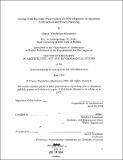Living with the past : preservation and development in Japanese architecture and town planning
Author(s)
Wendelken-Mortensen, Cherie
DownloadFull printable version (27.10Mb)
Alternative title
Preservation and development in Japanese architecture and town planning
Advisor
Stanford Anderson.
Terms of use
Metadata
Show full item recordAbstract
The study examines the architectural preservation program as it has developed over the past century in Japan, and demonstrates how relics of the past have been manipulated and re-interpreted by individuals and communities seeking to define a modern identity. The study chronicles the development of preservation practice from a national perspective, followed by a local historical analysis of the town of Tsumago in Nagano Prefecture. It is proposed that a nativist and modernist construction of the common Japanese house has had a special place in the history of the modern movement in Japan which influenced the conceptualization, study and preservation of traditional architecture over the past century. Also, the legal tools and field practices of both the national preservation program and the grass-roots district preservation movement have been tied to ideological and political concerns which have affected building designation, restoration, and public presentation. The most important example of the grass-roots district preservation movement in Japan is Tsumago-juku in Nagano Prefecture, the first example of such a movement in Asia. It is demonstrated that Tsumago's place in the formation of Japan's modern national identity was of primary importance to the success of its preservation effort. Restoration work there resulted in important national legislation and created a conflict between the "living tradition" of local carpentry and community vs. professional preservationist. This centered on the nature of architectural tradition and definition of authenticity. As a result of the preservation effort, the town's history and traditions have been re-invented to suit the needs of the present, and its material historicity has been compromised in the name of a greater authenticity in the building process. Yet the modernist ideal of a structurally "honest" and materially "natural" Japanese house has made the acceptance of preservation intervention problematic in the architectural community, further demonstrating that the way old houses are preserved is as much a reflection of the architectural and political ideology of our time as they are a portrait of the past.
Description
Thesis (Ph. D.)--Massachusetts Institute of Technology, Dept. of Architecture and Planning, 1994. Includes bibliographical references (v 2., leaves 309-325).
Date issued
1994Department
Massachusetts Institute of Technology. Department of Architecture; Massachusetts Institute of Technology. Department of Urban Studies and PlanningPublisher
Massachusetts Institute of Technology
Keywords
Architecture, Urban Studies and Planning